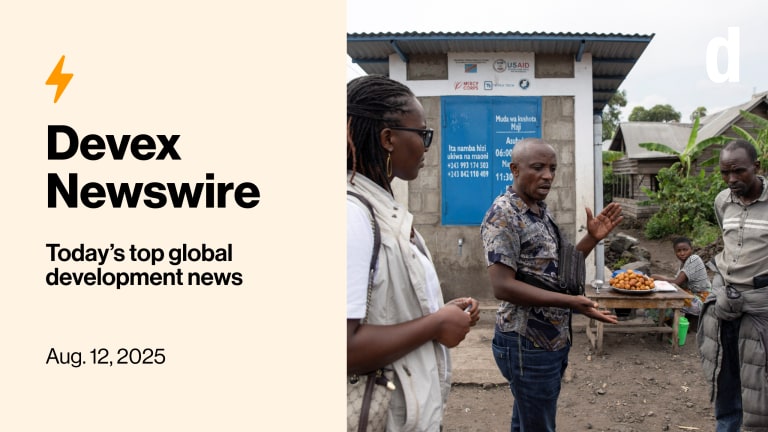A record year for USAID: Takeaways from its latest business forecast
USAID held its latest business forecast and update on its programs heading into 2023 and officials provided updates on funding, localization of projects, the release of a new acquisition and assistance strategy and efforts at diversity and inclusion.
The U.S. Agency for International Development had a record year in 2022. USAID spent $35.5 billion through acquisitions and assistance — about a $8.7 billion jump from 2021 — Deputy Assistant Administrator Mark Walther said during the agency's quarterly business forecast update on Dec.7. The agency had already seen large increases on its historical levels of spending in 2020 and 2021 due to the impact of the COVID-19 pandemic. “This nearly $8.7 billion increase from FY 2021 was in large part to USAID’s response in Ukraine and other humanitarian efforts along with our continued commitment to fighting the COVID-19 pandemic,” a USAID spokesperson told Devex in an email. Spending looks set to continue at a high level next year. For 2023, USAID said that it plans to fund 258 opportunities worth $33.7 billion, a nearly 23% increase from the same time last year. USAID has also seen its budgetary resources rise to almost $48 billion for the fiscal year 2022, up from $37.5 billion in 2021, according to data from USAspending.gov. In 2020 and prior years the agency’s budgetary resources had held steady at just over $26 billion. The agency spokesperson said that USAID annual appropriations contain different funding accounts with different requirements on how quickly they must be obligated. USAID was appropriated approximately $44.9 billion in base and supplemental full and partially managed funding in fiscal year 2022, the spokesperson said. “Some funds must be obligated in one year, some in two years, and some have no restrictions on when they must be obligated,” the USAID spokesperson told Devex. “As a result, USAID's appropriated budget and its annual obligations may differ in any given fiscal year. The Agency works diligently to obligate all of its appropriated funding.” On Dec. 7, USAID officials also provided an update on the agency’s work and plans for the coming year, including on funding, efforts to work with local organizations, or localization, the release of its new acquisition and assistance strategy, and efforts at diversity and inclusion. Funding for small business The agency had set a goal of granting 12.5% to small businesses and it exceeded that target: It hit 16%, nearly a billion dollars. For the coming year, USAID said it aims to fund 13.25% to small businesses. Walther said that the agency is in the process of finalizing its new acquisition and assistance strategy, the approach it uses to engage with partners on funding. “The final draft is with the agency's front office, the administrator, for review and final clearance, and that we do hope to publicly launch early next year,” Walther said. Localization USAID Administrator Samantha Power made a commitment a year ago to have at least a quarter of the agency’s funding go to entities in the country of operations by 2025. Power also set a goal that by 2030, 50% of the agency’s projects “will place local communities in the lead to set priorities, codesign projects, drive implementation, or evaluate the impact of our programs.” Sarah Rose, USAID senior adviser for localization, said that the agency expected organizations that work with it to use its guiding principle as laid out in the recently launched policy on local organizations to partner with them. Organizations can use the platform WorkWithUSAID.org to identify local partners to potentially work with. The directory has over 3,000 organizations, profiles and contact information, of which 60% are local to the countries in which USAID operates. “Our work will build on the unique expertise, resources and networks of all development actors, but in a way that supports and creates the conditions for local actors to take the lead to address local and in some cases, trans local challenges,” Rose said during the update on Dec.7. USAID plans to release its progress on direct local awards for 2022 in March. “We will also roll out a system for tracking the extent to which our activities are creating space for local actors to exercise leadership throughout the program cycle,” she said. Diversity and Inclusion Earlier this year, USAID appointed Neneh Diallo as its first diversity chief. In our profile of Diallo earlier this year, we showed how much work USAID still has to do to ensure more diversity, especially among its senior ranks. On Dec. 7, Diallo said that her office had launched an annual diversity and inclusion survey within the agency to collect voluntary demographic data from the agency’s entire workforce, including contractors and locally employed staff. “This data will better inform us on the climate and diversity of our global footprint,” she said. She said that data is now being compiled and will soon be available without providing specifics as to when it will be made public.
The U.S. Agency for International Development had a record year in 2022.
USAID spent $35.5 billion through acquisitions and assistance — about a $8.7 billion jump from 2021 — Deputy Assistant Administrator Mark Walther said during the agency's quarterly business forecast update on Dec.7.
The agency had already seen large increases on its historical levels of spending in 2020 and 2021 due to the impact of the COVID-19 pandemic.
This story is forDevex Promembers
Unlock this story now with a 15-day free trial of Devex Pro.
With a Devex Pro subscription you'll get access to deeper analysis and exclusive insights from our reporters and analysts.
Start my free trialRequest a group subscription Printing articles to share with others is a breach of our terms and conditions and copyright policy. Please use the sharing options on the left side of the article. Devex Pro members may share up to 10 articles per month using the Pro share tool ( ).
Omar Mohammed is a Foreign Aid Business Reporter based in New York. Prior to joining Devex, he was a Knight-Bagehot fellow in business and economics reporting at Columbia University Graduate School of Journalism. He has nearly a decade of experience as a journalist and he previously covered companies and the economies of East Africa for Reuters, Bloomberg, and Quartz.








